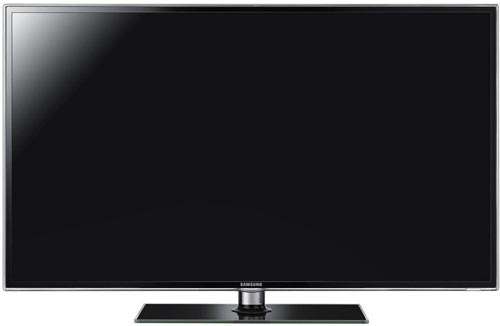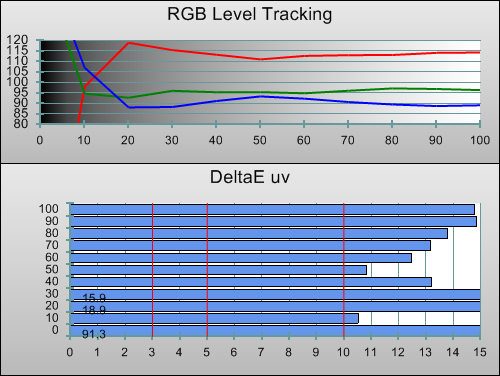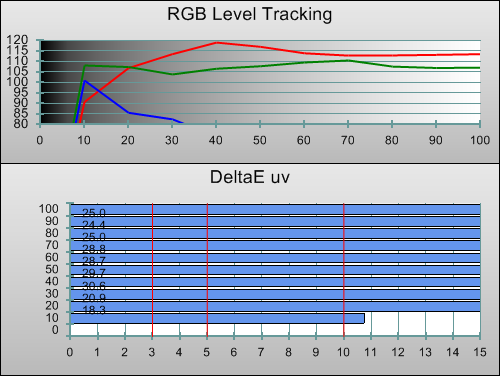It seems like Samsung is stopping at nothing to make ultra-slim LED side-lit displays the new standard for LCD TVs… the company’s UE40D6530, which includes this screen illumination technology and the associated slender profile, sits roughly in the middle of the company’s HDTV ranges. As such, we think it will be of great interest to users looking to snap up a 3D-capable LED-based LCD HDTV and still have some change left over.
<!-- google_ad_client = 'pub-2887677957235196'; google_ad_slot = '4990177225'; google_ad_width = 336; google_ad_height = 280; //-->
The initial specs of the Samsung UE40D6530 are impressive – compared to the company’s top end D8000 LED LCD television, it doesn’t appear that much has been shorn off of this more cost-conscious 3D TV. There are still 4 HDMI inputs, Freeview HD support, and the promise of Full HD 3D resolution. The only differences are the lack of the contrast-enhancing “Micro Dimming” feature, and a lower claimed motion resolution rate (which should translate into less crisp movement, although we’ll see for ourselves during this review). The panel also loses the satellite (Freesat) capabilities. The manufacturer’s extensive internet TV features and the “Smart Hub” still make an appearance, which is surprising.
We’ve been mostly very impressed with Samsung’s budget traditional LCD televisions in the past, so let’s see if the Korean giant can impress us now that edge LED backlight technology has been added to the mix.
Note: While we did not test the 32-inch Samsung UE32D6530, there shouldn’t be any significant difference in picture performance given that models in the D6530 series share similar specifications.
Jump To: Operation • Calibration • Picture Performance • Conclusion

The Samsung UE40D6530 is a beautifully styled HDTV, in fact, we actually prefer its appearance to the high-end D8000 model (although this is, of course, highly subjective). We’re happy to see that the four-legged, fingerprint-prone “claw” stand doesn’t make an appearance here. Instead, we’re treated to a more basic, but also very stylish square tabletop block with a “brushed steel” appearance – perhaps we’re just traditionalists, but we prefer this. The HDTV itself features a thin, shiny grey-black border, which is itself surrounded by glass-like transparent acrylic. The entire unit is only about 3cm thick. It is almost certainly the nicest looking LCD TV we’ve seen this year.
Although lacking the Satellite tuner input that more expensive Samsung HDTVs feature, the UE40D6530 still sports 4 HDMI inputs, support for SCART, Component, Composite video, PC “VGA”, and of course, a Freeview HD tuner. There’s also a LAN socket, although once again, even at this lessened price point, the LED LCD TV also features built-in Wireless capabilities, so we imagine it will go largely unused.
 |
| Rear: 4 x HDMI, VGA, component, SCART, aerial, ethernet & audio outs |
Samsung’s usual clear, legible menus make a return on the 40D6530. However, they’re more responsive than those seen on higher end models, because they lack the fancy transition animations – which is absolutely fine by us (more than fine, in fact). A quick look through the advanced picture settings menu reveals that the UE40D6530 features all of the calibration tools available on higher end displays. Samsung’s three-axis colour management system (CMS) and 10-point Greyscale adjustment menus are included here.
![[Picture] menu](https://www.hdtvtest.co.uk/news/wp-content/uploads/2018/04/hdtv_Samsung-UE40D6530_picmenu.jpg) |
| [Picture] menu |
Note: Our Samsung UE40D6530 review sample was calibrated using Calman Professional, the industry-leading video calibration software.
In its default mode, the Samsung D6530 was putting out a sharpened, blue-tinted, hyper-real image which doesn’t really suit high quality home viewing (but will certainly grab attention in crowded stores). We selected the “Movie” mode from the TV’s Picture menu, since this is the most accurate out of the box preset mode, and ran some initial Greyscale measurements to see how correct the television’s colour reproduction was. We left the “Colour Space” setting at “Auto” before making any complex colour adjustments.
 |
| Pre-calibration RGB tracking and delta errors (dEs) |
The pre-calibrated Greyscale tracking on our Samsung UE40D6530 review unit was very similar to what we saw from the high-end D8000 LED TV: overly red by default, but uniformly so. We imagine this won’t be overly troubling to users who aren’t used to watching accurate displays. To our eyes, it’s much easier to ignore than a picture that’s overly blue.
![Post-calibration RGB Tracking in [Movie] mode](https://www.hdtvtest.co.uk/news/wp-content/uploads/2018/04/hdtv_Samsung-UE40D6530_post-rgb.png) |
| Post-calibration RGB tracking and dEs in [Movie] mode |
We then calibrated the HDTV, so we could see what it was capable of when pushed to its absolute limits. Achieving essentially perfect Greyscale reproduction was a cinch thanks to the controls Samsung has provided. First we used the regular 2-point White Balance menu (which has six controls: RGB levels for both the low and high ends) to achieve highly accurate Greyscale tracking at all points. Then, we used the 10-point control to make smaller, more specific corrections – for example, to the 10% (shadowed) areas of the image, which still had a blue tint (common for LCD-based displays). The end result is absolutely excellent, even more so when the UE40D6530’s price is considered.
![Gamma curve in [Movie] mode](https://www.hdtvtest.co.uk/news/wp-content/uploads/2018/04/hdtv_Samsung-UE40D6530_post-gamma.png) | |
| Gamma curve in [Movie] mode | Corresponding gamma tracking |
Not everyone is aware of this, so let’s reiterate it: calibrators can also use the 10-point White Balance menu to flatten out the D6530’s Gamma tracking, by adjusting all three controls simultaneously. You can see the perfect results above for yourself. Since we calibrated to 2.2 (for usage in a normally lit room, and for consistency with our other reviews), we raised the [Gamma] setting to +1. Reducing it will give a “punchier” image, with lessened shadow details, more suitable for darkened viewing environments.
Before we did any specialist calibration work on the UE40D6530, we measured how its colour performed in the out-of-the-box settings. The answer is, very well indeed. Red, Green, and by extension, Yellow, were all suitably accurate, although the colour of Blue was slightly off, as was Magenta. Samsung’s three-axis colour management system allowed these errors to be corrected. The only sticking point was Blue, where we could minimise the error, but never saturate the colour fully. We did also feel that the adjustments were not as fine (that is to say, they were coarser) than on higher-end Samsung displays, but couldn’t verify this. In any case, we were very happy with the final accuracy.
![Post-calibration CIE chart in [Movie] mode](https://www.hdtvtest.co.uk/news/wp-content/uploads/2018/04/hdtv_Samsung-UE40D6530_post-cie.jpg) |
| Post-calibration CIE chart with reference to HD Rec.709 |
![Post-calibration Luminance levels in [Movie] mode](https://www.hdtvtest.co.uk/news/wp-content/uploads/2018/04/hdtv_Samsung-UE40D6530_post-colour-lum.png) |
| Post-calibration colour luminance (coloured bars = targets; black bars = measured values) |
Since the colour management menu indirectly allows for control over Luminance (or colour “brightness”), we weren’t surprised that we managed to achieve perfection in this area, also.
We attached a pair of Samsung’s SSG-3100GB active-shutter 3D glasses to the end of our Klein Instruments K-10 non-contact calibration meter, enabled 3D mode on the TV, and turned on the glasses. We then took the following measurements to get an idea of the picture quality of the UE40D6530 in its 3-dimensional mode.
 |
| 3D Pre-calibration RGB tracking and delta errors (dEs) |
Out-of-the-box accuracy was not a strong point, which wasn’t too surprising given the 40D6530’s price point. The image had a visible greenish appearance in 3D mode before calibration. In fact, when we saw the above measurements, we had to double-check that the glasses hadn’t shut themselves off during the reading.
![3D Post-calibration RGB Tracking in [Movie] mode](https://www.hdtvtest.co.uk/news/wp-content/uploads/2018/04/hdtv_Samsung-UE40D6530_3d-post-rgb.png) |
| 3D Post-calibration RGB tracking and dEs in [Movie] mode |
A large improvement was possible, but the final Greyscale tracking quality in 3D is basically on the same level as the company’s first-generation 3D LCD TVs. We could certainly have done with 10-point Greyscale controls here (Samsung doesn’t offer them in 3D mode on any of their models, unlike some other manufacturers), but that may be asking for a lot on a mid-range model. The final calibrated Greyscale quality could be described as “decent” in 3D, although this may be a moot point since most calibrators are not configuring the 3D modes of 3DTVs to this extent (perhaps in the years to come…)
As with all of Samsung’s 3DTV models, there is no separate colour memory for the 3D mode: colour management info is stored per-input, rather than “per dimension”. Although we could theoretically have achieved a better result by dedicating an entire HDMI input just to 3D display, we don’t think anyone would want the inconvenience of this (or the expense of having two players). This is the best practical result we managed to achieve:
![3D Post-calibration CIE chart in [Movie] mode](https://www.hdtvtest.co.uk/news/wp-content/uploads/2018/04/hdtv_Samsung-UE40D6530_3d-post-cie.jpg) |
| 3D Post-calibration CIE chart with reference to HD Rec.709 |
Prior to calibration, secondary colour points were somewhat skewed, but these became far more accurate after Greyscale adjustment.
![3D Post-calibration Luminance levels in [Movie] mode](https://www.hdtvtest.co.uk/news/wp-content/uploads/2018/04/hdtv_Samsung-UE40D6530_3d-post-colour-lum.png) |
| 3D Post-calibration colour luminance (coloured bars = targets; black bars = measured values) |
Luminance levels were initially too low. We adjusted these as best we could using the single “Colour” control, which we raised to “55” from its default position. Green, Cyan and Yellow remained a little too dark, though, and without practical individual control over these parameters, we had to accept this small limitation.
| Dead pixels | None |
| Screen uniformity | Very good: almost no bright/dark patches |
| Overscanning on HDMI | 0% with [P.SIZE] set to “Just Scan” |
| Blacker than black | Passed |
| Calibrated black level (black screen) | 0 cd/m2 (TV turns off LEDs) |
| Calibrated black level (ANSI checkerboard) | 0.04 cd/m2 |
| Black level retention | Stable with [Shadow Detail] set to +2 |
| Primary chromaticity | Very Good (mild error with Blue) |
| Scaling | Excellent, smooth, jaggy-free |
| Video mode deinterlacing | Very effective jaggies reduction |
| Film mode deinterlacing | Failed 2-2 PAL film cadence test |
| Viewing angle | Very Good for an LCD TV, slight colour loss |
| Motion resolution | 900, with some small “sparkling” around edges |
| Digital noise reduction | Mild film grain smoothing forced, except in “Game Mode” |
| Sharpness | Defeatable edge enhancement |
| Luma/Chroma bandwidth (2D Blu-ray) | Full Luma, Chroma horizontally blurred |
| 1080p/24 capability | No judder in 2D, judder with 3D Blu-ray movies |
| Input lag | 46ms compared to lag-free CRT |
| Full 4:4:4 reproduction (PC) | No, 4:4:4 input subsampled in all modes |
| Default [Standard] mode (2D) | 74 watts |
| Default [Standard] mode (3D) | 90 watts |
| Calibrated [Movie] mode (2D) | 80 watts |
| Calibrated [Movie] mode (3D) | 90 watts |
| Standby | 1 watt |
During the day, we could hardly be happier with the UE40D6530’s contrast performance. The “Ultra Clear Panel” allows the image to have a wonderful “glossy” appearance. As usual, viewing in a darkened room was a bit more revealing, but the blacks still held up very well, measuring 0.04 cd/m2 when measured with an ANSI checkerboard test pattern (which gives a very good indication of contrast performance with actual content). This is opposed to measuring the Samsung D6530 with a fully black screen, which of course returns a value of 0 cd/m2 (absolute black), since the TV shuts its LEDs off to save power.
Prior to calibration, we tried out all the different motion-affecting settings on the Samsung UE40D6530, and settled on enabling [Motion Plus] with the “Custom” mode set for maximum blur reduction and no judder reduction. We also enabled [LED Motion Plus], which makes a noticeable improvement to the reproduction of fine moving details (at the expense of some brightness – moreso, we think, than the higher-end implementations of the same feature). The 40D6530 is not as bright as some other Samsung flat-screen televisions, even with its [Backlight] setting turned up full, but even in this configuration, it was putting out enough light for our fairly standard environment.
The HDTV resolved around 900-1000 lines in the FPD Benchmark test chart, although the [LED Motion Plus] setting required to achieve this result did cause some slight “sparkling” (which we presume is the result of the LCD panel being overdriven). It was far less severe than the similar noisy dithering artefacts we see on some Plasma TVs, though.
Overall, motion wasn’t quite as clear as the top-end LCD TVs, and certainly not on the same level as Plasmas, but it was sharp enough for us not to mind given the price point. Users who plan on watching sports or other high-motion video content might want to double-check before they buy, but we had very few complaints with the performance on offer here: it’s still very good for an LCD television.
The first thing we checked out with the UE40D6530 was its 3D capabilities, by running our own 3D resolution test chart. Simply put, it doesn’t do well in this area at all, showing the lowest resolution out of any active-shutter 3D TV we’ve tested. It does seem that Samsung has felt compelled to shoe-horn 3D capabilities into a panel that’s not really suited to it, and the result is what looks like halved vertical resolution. Everything in 3D mode – the image you’re watching, and the 3DTV’s own on-screen menus – displays with jaggedness. This is likely to be even more obvious than any 2D errors might have been, given that it’s advisable to sit closer to the screen of an extra-dimensional television for a more immersive experience.
The vertical resolution check area of our test pattern appeared as a solid grey smudge (it’s supposed to be alternating black and white lines), and the diagonal “stipple” pattern did, too. Unfortunately for Samsung, there is a large “FULL HD 3D” logo displayed prominently on the UE40D6530’s box, which, we’re sorry to say, simply isn’t true. Given that Samsung has publicly denounced its cross-town rival LG over the latter’s usage of the term “Full HD 3D” to describe its passive Cinema 3D displays, this is more than a little ironic. We can only assume this is a promotional mistake of some sort, or that in these early days of 3D, a lack of test patterns (we had to made our own) means that TV makers may simply not be entirely or collectively aware of such limitations.
The Samsung UE40D6530 isn’t the only 3DTV promoted as “Full HD 3D” to actually not be – none of the 2011 Panasonic Plasma TV panels we’ve reviewed have been able to reproduce all 1080 lines of the 3D image, although they’re very close and the limitation is nowhere near as extreme. In fact, the only TV manufacturers we haven’t seen slip up in the resolution area so far have been Toshiba and Sony (although we’ve not seen all of their 3D range). This is unfortunate, because one of the greatest strengths of the active-shutter 3D system that Samsung promotes against the Passive system (which LG are proponents of) is… resolution. With this resolution limitation, we’re only left with the down-sides of the active-shutter 3D method – namely expensive glasses, and some flicker visible in bright areas.
Moving on, motion was a mixed bag. To our surprise, 50hz video in 3D played back without any stuttering at all – something that even the top-end D8000 series of LED TV needs some help with (but can manage eventually). The same is true of 60hz. Unfortunately, we couldn’t get 24fps films – such as those on Blu-ray 3D – to play back with what we call “cinema quality” motion (ideally, we want the picture to show without any new motion being generated by the TV, and also without any juddering). When we turned off all of the D6530’s motion smoothing controls, it was clearly adding a lot of unwanted juddering into the image. As a result, we did something we normally never do, and experimented with the motion smoothing controls for 3D film content. Normally we avoid these controls, since they introduce the so-called “soap opera effect”, causing filmic motion to become video-like. However, many users may prefer this to the stutter introduced with 3D movies otherwise. Unfortunately, the mode isn’t saved independently for 2D and 3D, so users will have to switch back and forth if they deem this to be a workable solution.
We then did some subjective viewing to check for 3D crosstalk and assess the overall image quality. We’re not sure if it’s down to the resolution handicap blinding us to whatever other qualities the image might have, or if it’s just the smaller 40″ screen size, but the image certainly didn’t seem to have the same depth as Samsung’s other 3D displays. Even Cloudy With A Chance Of Meatballs, which usually softens even the most grizzled of 3D hearts, didn’t leap out like we were used to. Crosstalk is present, although not to a horribly damaging extent.
All in all, the 3D performance is something of a blight on the Samsung UE40D6530, and only really serves to damage the company’s attempts at promoting active shutter as the superior 3D system.
SD material looked nearly as good as it possibly could on the Samsung UE40D6530. Samsung’s “crown jewel” is certainly its scaling engine. It’s not to everyone’s taste, because it doesn’t look as immediately razor-sharp as some other scalers, but it’s ideal for standard-def Digital TV because it appears to resize the image in a way which conceals compression artefacts, mosquito noise, and avoids aliasing (jaggedness). Of course, the company’s own “MPEG Noise Reduction” is gentle and non-destructive, too (although don’t expect to use it to watch Chinese VCDs and have them look compression artefact free!).

Diagonal interpolation (for concealing jaggies on video content) was very good. Film mode detection for PAL 2-2 content (in other words, nearly any film broadcast on television) wasn’t so consistent: we couldn’t get it to lock onto the cadence of the film motion test and stay locked in any of its modes. However, we didn’t find this too big an issue since we imagine most users will have upscaling DVD players with their own film mode detection circuitry (making the TV redundant for everything except movies on Digital TV, which are generally too soft to reveal this limitation much anyway). Unsurprisingly, the performance with the American-centric NTSC system was flawless for all intents and purposes.
We were very happy that the Samsung UE40D6530 reproduced cinema-quality motion when fed 24p Blu-ray Disc movies in 2D: that is, it was possible to configure it to show films without any unwanted motion interpolation (“soap opera effect”) and also without any unwanted juddering. We used the “Custom” [Motion Plus] mode and selected Blur Reduction: 10, Judder Reduction: 0 to achieve this. We confirmed that absolutely no motion interpolation was taking place with our own custom test pattern, designed to catch such processing.
Samsung’s (almost) undefeatable noise reduction processing is still in play here, but it’s not as noticeable as it has been in the past for two reasons: first is the smaller 40″ screen, second is the fact that they’ve fixed the bug whereby the filter would reset to its highest setting, causing very obvious smearing. It’s still silly to deny the user the choice of turning it off completely, from our point of view. However, any users who are troubled by this can enable the “Game Mode” setting on the UE40D6530. This disables the 10-point White Balance control (losing a bit of Greyscale neutrality) and means “Motion Plus” can’t be used (not really an issue for films), but fortunately does not add any extra judder to the image – smooth 24p, cinema-quality motion can be had even in “Game Mode”. (We also ran a quick test calibration on the “Game Mode” of this display, for users who wouldn’t be able to tolerate the remaining film grain smearing, and were happy with the Greyscale, Gamma and Colour quality on offer).
Viewed during the day, the panel produces an incredibly deep, believable black, with the screen’s coating being just glossy enough to give the image some additional perceived depth, but not so glossy as to become a secondary mirror. This is thanks to the “Ultra Clear Panel”, a screen coating which we think Samsung has down to a T.

Two other strengths of the Samsung UE40D6530 are, surprisingly, its screen uniformity, and its viewing angle. The colours do desaturate a little when viewed from the sides, and overall brightness does change, but the effect seems more minor compared to many other LCD televisions. Oddly, the Greyscale qualities of the screen didn’t noticeably degrade from the sides – whereas many other LCDs (Samsung’s included) can pick up a mild pinkish tint from the sides, there was nothing of the sort to be seen here.
As for screen uniformity, the 40D6530, while imperfect, presents much less obvious uneveness than the higher-end Samsung LCDs we’ve reviewed. We imagine this is purely down to screen size, though: the higher-end models were 46″ and 55″, whereas this display is 40″. By extrapolation, the 32″ UE32D6530 should be even better in this regard.
And, of course, we ask readers to cast their eyes back to the calibration section – the UE40D6530 is capable of very flat Greyscale tracking (both in and out of “Game Mode”), allowing the picture to be free of unwanted colour casts. Its colour accuracy is also very good before and after calibration, resulting in natural, realistic images.
Subjectively, the familiar Halo: Reach (which, as a first person shooter, is a good candidate for testing display lag) felt a little tight and unresponsive on the Samsung UE40D6530, although it was still possible to play and do fairly well in online games (long-term owners of laggy displays can sometimes effectively adapt their gameplay around the lag, also). We measured the input lag as being 46ms, which explained the “tightness” we felt.
We also played the new Xbox Live Arcade game Insanely Twisted Shadow Planet – most of which is styled in dark black shadows, as the name suggests – to see how well the LCD panel would hold up. The SPVA-type LCD panels that Samsung use, while arguably the best type of LCD panel for use in an HDTV, often show visible ghosting with dark objects, which is why we checked. Although there was some trailing, it was nowhere near as bad as we were expecting.
Also, speaking personally a Plasma TV owner, although I’m not overly concerned with image retention, it is still an annoyance which can still crop up with the competing display technology. It was nice to play games on a high-quality screen (albeit one that would ideally be a little less laggy) without watching the clock.
At an online price of around £800, the Samsung UE40D6530 presents very good value for money and, in 2D, produces deep, involving, accurate, high contrast video with an absolutely beautiful slim design. Surprisingly, the screen uniformity is very good for an edge LED-backlit LCD TV. As such, we would rather think of this as an excellent 2D HDTV, and just forget about its poor attempt at 3D. Were it to be more expensive, we wouldn’t be so lenient, but given the price the D6530 can be had for, and its other strengths, we don’t think it’s too unreasonable to write the 3D mode off as an experiment gone wrong (although Samsung should revisit the “Full HD 3D” label associated with this 3DTV, because it just isn’t true).
We still don’t like the fact that users are not given full control over the [Noise Reduction] setting, and that we have to enable and set up the “Game Mode” (and give up a little bit of Greyscale neutrality) just to see films without any unwanted grain reduction processing. Fortunately, the work-around for this isn’t hugely damaging, meaning that this hasn’t affected the final recommendation much.
If you’re looking for a brilliantly styled, high-performing LCD TV for watching 2D standard-def and HD TV and films on, the Samsung UE40D6530 is it. Hardcore gamers might want to look elsewhere to get a slightly faster screen, and we can’t recommend it at all for 3D. However, if the Korean manufacturer can keep producing LED-assisted LCDs to this standard, we may end up not missing the traditional CCFL-backlit LCD TVs after all.
Note: the final score ignores the 3D mode of the D6530 due to the fact that it is priced on par with 2D-only models.

<!-- google_ad_client = 'pub-2887677957235196'; google_ad_slot = '0693194791'; google_ad_width = 336; google_ad_height = 280; //-->